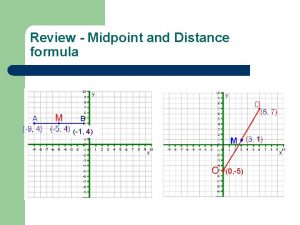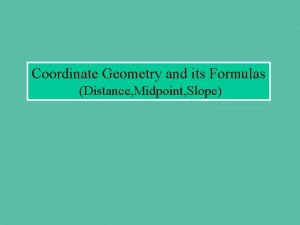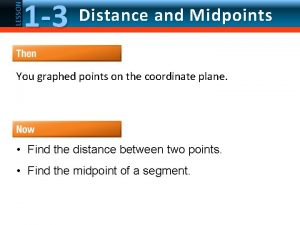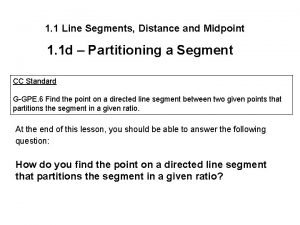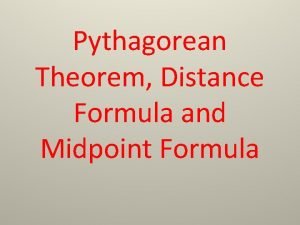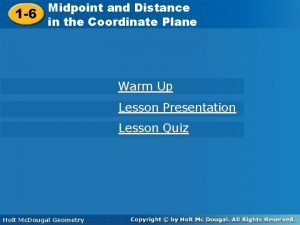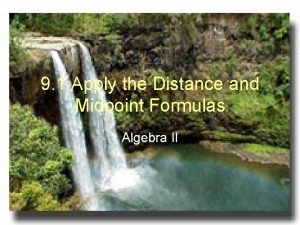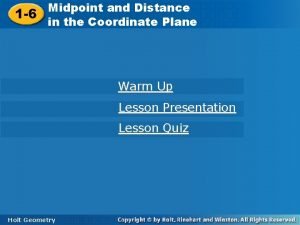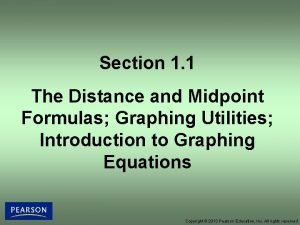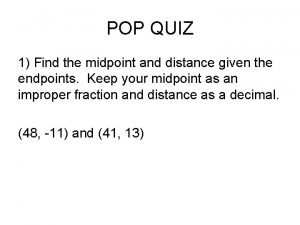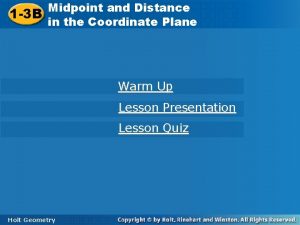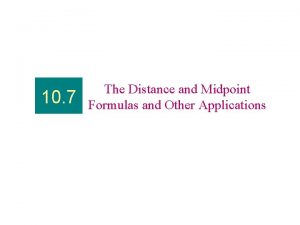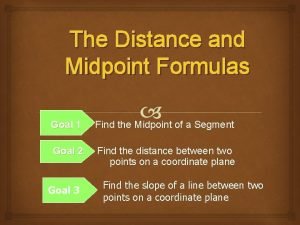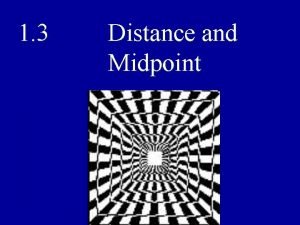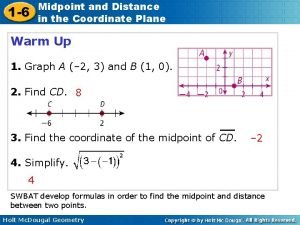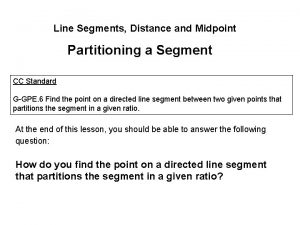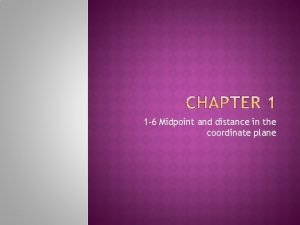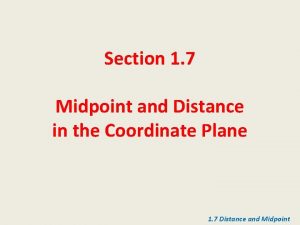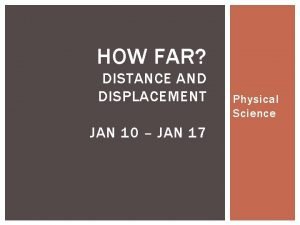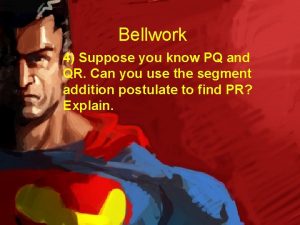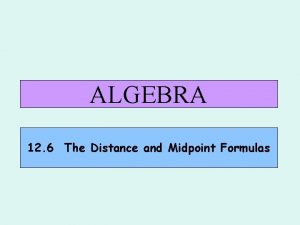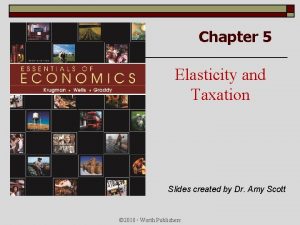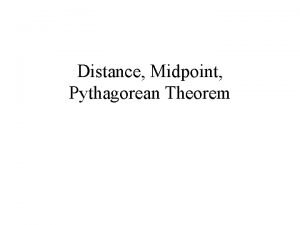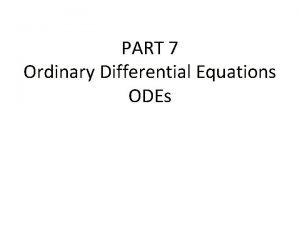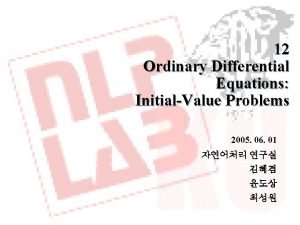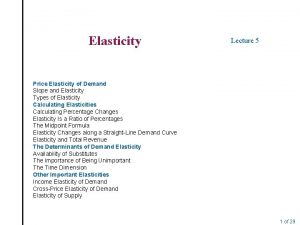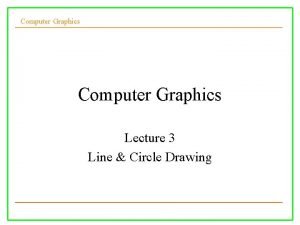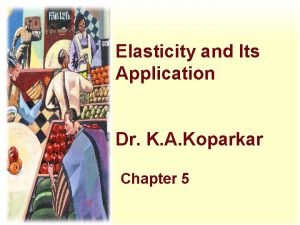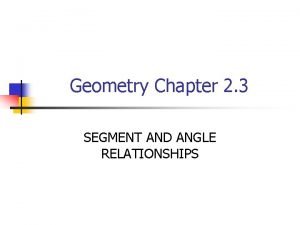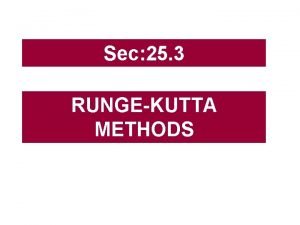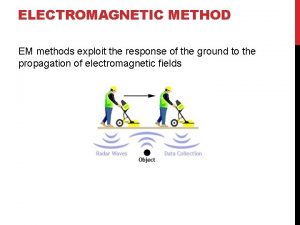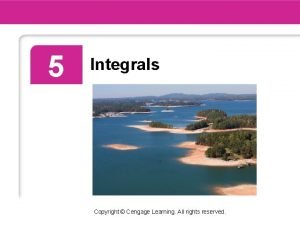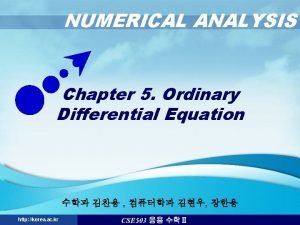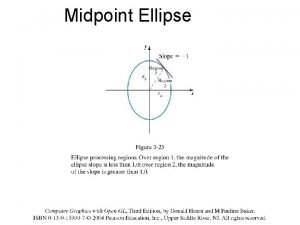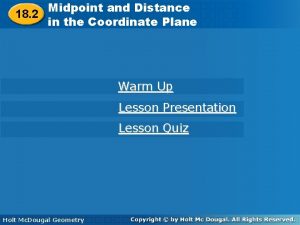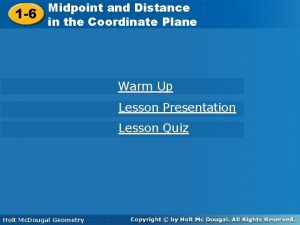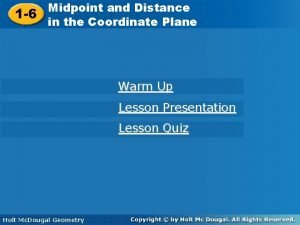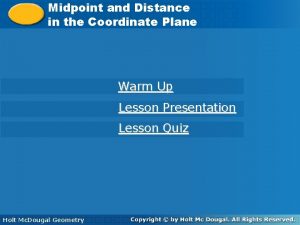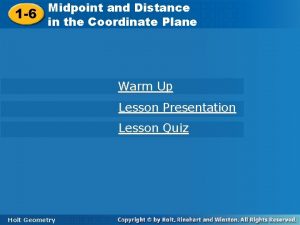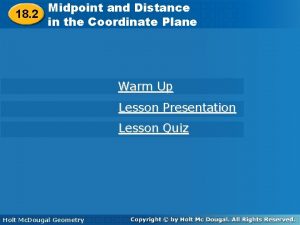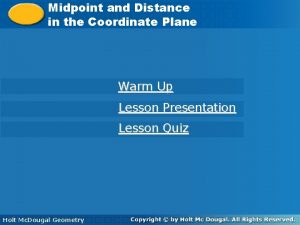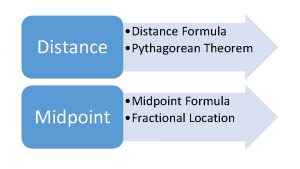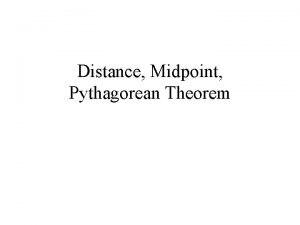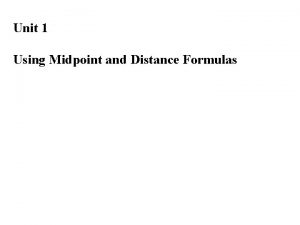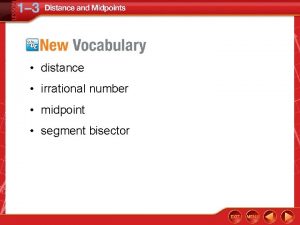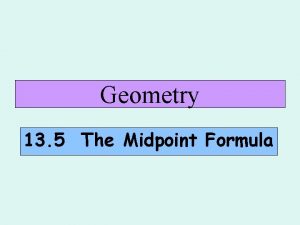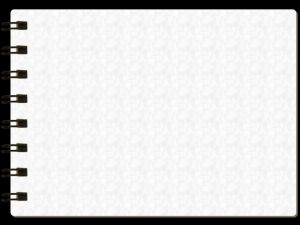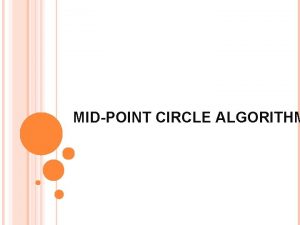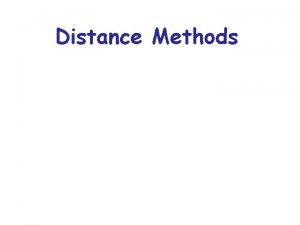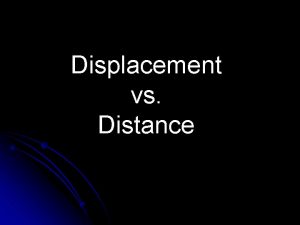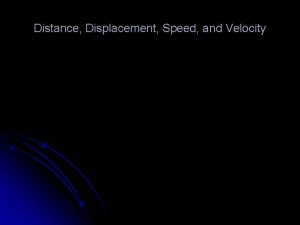Midpoint andand Distance Midpoint Distance 1 6 in










































- Slides: 42

Midpoint andand Distance Midpoint Distance 1 -6 in the Coordinate Plane Warm Up Lesson Presentation Lesson Quiz Holt Geometry

1 -6 Midpoint and Distance in the Coordinate Plane Warm Up 1. Draw a line that divides a right angle in half. 2. Draw three different squares with (3, 2) as one vertex. 3. Find the values of x and y if (3, – 2) = (x + 1, y – 3) x = 2; y = 1 Holt Geometry

Midpoint and Distance 1 -6 1 -7 in. Transformations in the Coordinate Plane Warm Up Lesson Presentation Lesson Quiz Holt Geometry

1 -6 Midpoint and Distance in the Coordinate Plane Warm Up Add or subtract. 1. 4 + (– 6) – 2 2. – 3 + 5 2 3. – 7 – 14 4. 2 – (– 1) 3 Find the x- and y-intercepts. 5. x + 2 y = 8 x-intercept: 8; y-intercept: 4 6. 3 x + 5 y = – 15 Holt Geometry x-intercept: – 5; y-intercept: – 3

1 -6 Midpoint and Distance in the Coordinate Plane Warm Up Simplify. 1. 2. 3. (6 − 10)2 16 4. (− 1 − 5)2 36 2 Find each square root to the nearest tenth. 5. 4. 2 6. 7. 7 7. 9. 2 8. 6. 1 Holt Geometry

1 -6 Midpoint and Distance in the Coordinate Plane You can also use the Pythagorean Theorem to find the distance between two points in a coordinate plane. You will learn more about the Pythagorean Theorem in Chapter 5. In a right triangle, the two sides that form the right angle are the legs. The side across from the right angle that stretches from one leg to the other is the hypotenuse. In the diagram, a and b are the lengths of the shorter sides, or legs, of the right triangle. The longest side is called the hypotenuse and has length c. Holt Geometry

1 -6 Midpoint and Distance in the Coordinate Plane Holt Geometry

1 -6 Midpoint and Distance in the Coordinate Plane Example 4: Finding Distances in the Coordinate Plane Use the Distance Formula and the Pythagorean Theorem to find the distance, to the nearest tenth, from D(3, 4) to E(– 2, – 5). Holt Geometry

1 -6 Midpoint and Distance in the Coordinate Plane Example 4 Continued Method 1 Use the Distance Formula. Substitute the values for the coordinates of D and E into the Distance Formula. Holt Geometry

1 -6 Midpoint and Distance in the Coordinate Plane Example 4 Continued Method 2 Use the Pythagorean Theorem. Count the units for sides a and b. a = 5 and b = 9. c 2 = a 2 + b 2 = 52 + 9 2 = 25 + 81 = 106 c = 10. 3 Holt Geometry

1 -6 Midpoint and Distance in the Coordinate Plane Check It Out! Example 4 a Use the Distance Formula and the Pythagorean Theorem to find the distance, to the nearest tenth, from R to S. R(3, 2) and S(– 3, – 1) Method 1 Use the Distance Formula. Substitute the values for the coordinates of R and S into the Distance Formula. Holt Geometry

1 -6 Midpoint and Distance in the Coordinate Plane Check It Out! Example 4 a Continued Use the Distance Formula and the Pythagorean Theorem to find the distance, to the nearest tenth, from R to S. R(3, 2) and S(– 3, – 1) Holt Geometry

1 -6 Midpoint and Distance in the Coordinate Plane Check It Out! Example 4 a Continued Method 2 Use the Pythagorean Theorem. Count the units for sides a and b. a = 6 and b = 3. c 2 = a 2 + b 2 = 62 + 3 2 = 36 + 9 = 45 Holt Geometry

1 -6 Midpoint and Distance in the Coordinate Plane Check It Out! Example 4 b Use the Distance Formula and the Pythagorean Theorem to find the distance, to the nearest tenth, from R to S. R(– 4, 5) and S(2, – 1) Method 1 Use the Distance Formula. Substitute the values for the coordinates of R and S into the Distance Formula. Holt Geometry

1 -6 Midpoint and Distance in the Coordinate Plane Check It Out! Example 4 b Continued Use the Distance Formula and the Pythagorean Theorem to find the distance, to the nearest tenth, from R to S. R(– 4, 5) and S(2, – 1) Holt Geometry

1 -6 Midpoint and Distance in the Coordinate Plane Check It Out! Example 4 b Continued Method 2 Use the Pythagorean Theorem. Count the units for sides a and b. a = 6 and b = 6. c 2 = a 2 + b 2 = 62 + 6 2 = 36 + 36 = 72 Holt Geometry

1 -6 Midpoint and Distance in the Coordinate Plane Example 5: Sports Application A player throws the ball from first base to a point located between third base and home plate and 10 feet from third base. What is the distance of the throw, to the nearest tenth? Holt Geometry

1 -6 Midpoint and Distance in the Coordinate Plane Example 5 Continued Set up the field on a coordinate plane so that home plate H is at the origin, first base F has coordinates (90, 0), second base S has coordinates (90, 90), and third base T has coordinates (0, 90). The target point P of the throw has coordinates (0, 80). The distance of the throw is FP. Holt Geometry

1 -6 Midpoint and Distance in the Coordinate Plane Check It Out! Example 5 The center of the pitching mound has coordinates (42. 8, 42. 8). When a pitcher throws the ball from the center of the mound to home plate, what is the distance of the throw, to the nearest tenth? 60. 5 ft Holt Geometry

1 -7 Transformations in the Coordinate Plane Objectives Identify reflections, rotations, and translations. Graph transformations in the coordinate plane. Holt Geometry

1 -7 Transformations in the Coordinate Plane Vocabulary transformation preimage Holt Geometry reflection rotation translation

1 -7 Transformations in the Coordinate Plane The Alhambra, a 13 th-century palace in Grenada, Spain, is famous for the geometric patterns that cover its walls and floors. To create a variety of designs, the builders based the patterns on several different transformations. A transformation is a change in the position, size, or shape of a figure. The original figure is called the preimage. The resulting figure is called the image. A transformation maps the preimage to the image. Arrow notation ( ) is used to describe a transformation, and primes (’) are used to label the image. Holt Geometry

1 -7 Transformations in the Coordinate Plane Holt Geometry

1 -7 Transformations in the Coordinate Plane Holt Geometry

1 -7 Transformations in the Coordinate Plane Holt Geometry

1 -7 Transformations in the Coordinate Plane Holt Geometry

1 -7 Transformations in the Coordinate Plane Example 1 A: Identifying Transformation Identify the transformation. Then use arrow notation to describe the transformation. The transformation cannot be a reflection because each point and its image are not the same distance from a line of reflection. 90° rotation, ∆ABC ∆A’B’C’ Holt Geometry

1 -7 Transformations in the Coordinate Plane Example 1 B: Identifying Transformation Identify the transformation. Then use arrow notation to describe the transformation. The transformation cannot be a translation because each point and its image are not in the same relative position. reflection, DEFG D’E’F’G’ Holt Geometry

1 -7 Transformations in the Coordinate Plane Check It Out! Example 1 Identify each transformation. Then use arrow notation to describe the transformation. a. translation; MNOP M’N’O’P’ Holt Geometry b. rotation; ∆XYZ ∆X’Y’Z’

1 -7 Transformations in the Coordinate Plane Example 2: Drawing and Identifying Transformations A figure has vertices at A(1, – 1), B(2, 3), and C(4, – 2). After a transformation, the image of the figure has vertices at A'(– 1, – 1), B'(– 2, 3), and C'(– 4, – 2). Draw the preimage and image. Then identify the transformation. Plot the points. Then use a straightedge to connect the vertices. The transformation is a reflection across the y-axis because each point and its image are the same distance from the y-axis. Holt Geometry

1 -7 Transformations in the Coordinate Plane Check It Out! Example 2 A figure has vertices at E(2, 0), F(2, -1), G(5, -1), and H(5, 0). After a transformation, the image of the figure has vertices at E’(0, 2), F’(1, 2), G’(1, 5), and H’(0, 5). Draw the preimage and image. Then identify the transformation. Plot the points. Then use a straightedge to connect the vertices. The transformation is a 90° counterclockwise rotation. Holt Geometry

1 -7 Transformations in the Coordinate Plane To find coordinates for the image of a figure in a translation, add a to the x-coordinates of the preimage and add b to the y-coordinates of the preimage. Translations can also be described by a rule such as (x, y) (x + a, y + b). Holt Geometry

1 -7 Transformations in the Coordinate Plane Example 3: Translations in the Coordinate Plane Find the coordinates for the image of ∆ABC after the translation (x, y) (x + 2, y - 1). Draw the image. Step 1 Find the coordinates of ∆ABC. The vertices of ∆ABC are A(– 4, 2), B(– 3, 4), C(– 1, 1). Holt Geometry

1 -7 Transformations in the Coordinate Plane Example 3 Continued Step 2 Apply the rule to find the vertices of the image. A’(– 4 + 2, 2 – 1) = A’(– 2, 1) B’(– 3 + 2, 4 – 1) = B’(– 1, 3) C’(– 1 + 2, 1 – 1) = C’(1, 0) Step 3 Plot the points. Then finish drawing the image by using a straightedge to connect the vertices. Holt Geometry

1 -7 Transformations in the Coordinate Plane Check It Out! Example 3 Find the coordinates for the image of JKLM after the translation (x, y) (x – 2, y + 4). Draw the image. Step 1 Find the coordinates of JKLM. The vertices of JKLM are J(1, 1), K(3, 1), L(3, – 4), M(1, – 4), . Holt Geometry

1 -7 Transformations in the Coordinate Plane Check It Out! Example 3 Continued Step 2 Apply the rule to find the vertices of the image. J’(1 – 2, 1 + 4) = J’(– 1, 5) J’ K’ K’(3 – 2, 1 + 4) = K’(1, 5) L’(3 – 2, – 4 + 4) = L’(1, 0) M’(1 – 2, – 4 + 4) = M’(– 1, 0) Step 3 Plot the points. Then finish drawing the image by using a straightedge to connect the vertices. Holt Geometry M’ L’

1 -7 Transformations in the Coordinate Plane Example 4: Art History Application The figure shows part of a tile floor. Write a rule for the translation of hexagon 1 to hexagon 2. Step 1 Choose two points. Choose a Point A on the preimage and a corresponding Point A’ on the image. A has coordinate (2, – 1) and A’ has coordinates Holt Geometry A’ A

1 -7 Transformations in the Coordinate Plane Example 4 Continued The figure shows part of a tile floor. Write a rule for the translation of hexagon 1 to hexagon 2. Step 2 Translate. To translate A to A’, 2 units are subtracted from the xcoordinate and 1 units are added to the y-coordinate. Therefore, the translation rule is (x, y) → (x – 3, y + 1 ). Holt Geometry A’ A

1 -7 Transformations in the Coordinate Plane Check It Out! Example 4 Use the diagram to write a rule for the translation of square 1 to square 3. Step 1 Choose two points. Choose a Point A on the preimage and a corresponding Point A’ on the image. A has coordinate (3, 1) and A’ has coordinates (– 1, – 3). Holt Geometry A’

1 -7 Transformations in the Coordinate Plane Check It Out! Example 4 Continued Use the diagram to write a rule for the translation of square 1 to square 3. Step 2 Translate. To translate A to A’, 4 units are subtracted from the xcoordinate and 4 units are subtracted from the y -coordinate. Therefore, the translation rule is (x, y) (x – 4, y – 4). Holt Geometry A’

1 -7 Transformations in the Coordinate Plane Lesson Quiz: Part I 1. A figure has vertices at X(– 1, 1), Y(1, 4), and Z(2, 2). After a transformation, the image of the figure has vertices at X'(– 3, 2), Y'(– 1, 5), and Z'(0, 3). Draw the preimage and the image. Identify the transformation. translation 2. What transformation is suggested by the wings of an airplane? reflection Holt Geometry

1 -7 Transformations in the Coordinate Plane Lesson Quiz: Part II 3. Given points P(-2, -1) and Q(-1, 3), draw PQ and its reflection across the y-axis. 4. Find the coordinates of the image of F(2, 7) after the translation (x, y) (x + 5, y – 6). (7, 1) Holt Geometry
 Distance midpoint and angle measurement
Distance midpoint and angle measurement Midpoint and distance formula
Midpoint and distance formula Lesson 1-3 midpoint and distance
Lesson 1-3 midpoint and distance Partitioning a line segment formula
Partitioning a line segment formula Distance and midpoint formula
Distance and midpoint formula Lesson 1-6 midpoint and distance in the coordinate plane
Lesson 1-6 midpoint and distance in the coordinate plane 9-1 midpoint and distance formulas
9-1 midpoint and distance formulas Lesson 1-6 midpoint and distance in the coordinate plane
Lesson 1-6 midpoint and distance in the coordinate plane Distance & midpoint formulas
Distance & midpoint formulas Distance and midpoint quiz
Distance and midpoint quiz Practice b midpoint and distance in the coordinate plane
Practice b midpoint and distance in the coordinate plane Distance and midpoint formula
Distance and midpoint formula Midpoint formula definition
Midpoint formula definition 1-3 midpoint and distance
1-3 midpoint and distance Midpoint and distance in the coordinate plane worksheet 1-6
Midpoint and distance in the coordinate plane worksheet 1-6 Midpoint in the coordinate plane
Midpoint in the coordinate plane Partitioning a line segment example
Partitioning a line segment example Midpoint and distance formula worksheet
Midpoint and distance formula worksheet 1-7 midpoint and distance in the coordinate plane
1-7 midpoint and distance in the coordinate plane The ratio of input distance to output distance
The ratio of input distance to output distance What is the difference between distance and displacement
What is the difference between distance and displacement Nanocad midpoint
Nanocad midpoint Suppose you know pq and qr
Suppose you know pq and qr Midpoint formula algebra
Midpoint formula algebra Midpoint method formula
Midpoint method formula Endpoint formula
Endpoint formula Midpoint method formula
Midpoint method formula Double integral midpoint rule
Double integral midpoint rule Midpoint method formula
Midpoint method formula Midpoint formula economics
Midpoint formula economics Dda circle drawing algorithm can be used to draw
Dda circle drawing algorithm can be used to draw Midpoint method price elasticity of demand
Midpoint method price elasticity of demand What is definition of congruent segments
What is definition of congruent segments Heun method
Heun method Common midpoint
Common midpoint Midpoint riemann formula
Midpoint riemann formula Salary range spread calculation
Salary range spread calculation Circle distance formula
Circle distance formula Euler midpoint method
Euler midpoint method Midpoint eq
Midpoint eq Point method of elasticity of demand
Point method of elasticity of demand Cohen-sutherland algorithm
Cohen-sutherland algorithm Midpoint formula economics
Midpoint formula economics
